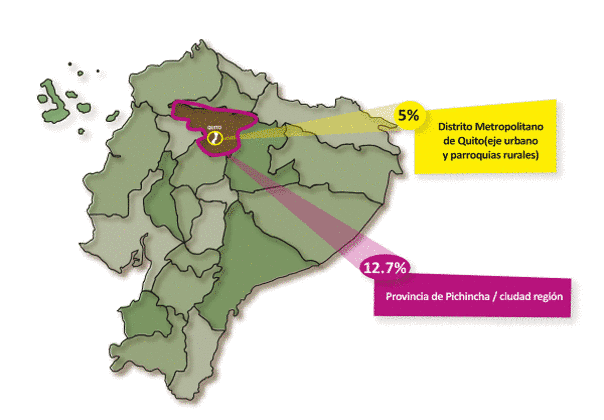Quito, Ecuador
Background
The Metropolitan District of Quito (DMQ), the capital city of Ecuador, is currently home to about 2.5 million people, representing ca 16% of the total national population and 87% of the population of the Pichincha province in which it is located. In Quito, poverty – expressed as non-satisfied basic needs- affects almost 30% of the population, while extreme poverty reaches 7% and almost 30% of the children below 5 years suffer from chronic malnutrition. The city has an urban unemployment rate of 5%, and an underemployment rate of 40% (INEC, 2015).
Since the late 1980s, Quito’s urban and industrial growth is characterised by low- density extension and dispersion into the peri-urban and rural valleys surrounding the city. Its urban population doubled between 1980 and 2000, and current projections are that the city’s population will grow from the actual 2.5 million to more than 2.8 million by 2022. Urban demand for food will only increase while urban food security is increasingly challenged by lack of food access, increasing food prices and potential supply problems.
The Quito city region
The Province of Pichincha, in which Quito is located, is identified as the most appropriate scale of the city region. The two rings in the image below identify the degree of self-sufficiency consumption of food for the given territory (ring). It compares total food consumption (by weight) of the population in the given territory for specific products with actual production in that area. Consumption figures are based on household consumption data multiplied by population figures. Production data are based on data from agricultural census. The calculation does not account for any food imports or exports, nor for food losses and waste. The second ring was identified as the city region as it includes key production areas, major food processing industry and allows for cross-jurisdictional planning coordination between the city of Quito, surrounding municipalities and the Province.

Main challenges for the Quito city region food system
The CRFS assessment done in Quito has shown the vulnerability of Quito’s food system where Quito ceased to depend on food produced in its immediate rurality and that Quito´s food resilience is low in the face of high food insecurity, increasing food prices and vulnerability to climatic, seismic, volcanic and earthmoving events.

Key challenges for a more sustainable and resilient Quito city region food system include the need to:
- Integrate food and agriculture into city development planning. This includes the inclusion of local/regional food systems planning in the Quito Vision 2040 development plan, in its Resilience Strategy and in city land use plans.
- Develop a territorial food strategy that will strengthen linkages between urban and rural areas, promoting both sustainable rural development and farmer livelihoods as well as urban development and a resilient urban food system that enhances food sovereignty and nutritious diets for the population in the city region.
- Strengthen participatory food governance mechanisms that build on the participation and engagement of key local actors (civil society, private sector, small producers, different levels of government).
Main climate shocks and stresses and disaster risks
(Note: This content is currently being generated by the project at the national level. It will be updated soon with the relevant information. )
The way forward
The Quito, the CRFS process has culminated in the design of a territorial food strategy or policy. Following a participatory stakeholder consultation process, engaging the participation of a broad number of local, provincial and national government departments and representatives, civil society organisations, research institutes, international organisations and private sector, a common vision, goals and outcomes for the food policy were identified. For each key pillar and outcome, targets and baseline indicators were set. In addition, key activities were identified and stakeholder roles and timelines defined.

Some of the proposed actions include:
- The strengthening of Quito’s urban agriculture programme in terms of enhancing the quality and quantity of local food production and by facilitating more diversified market mechanisms.
- The creation of a programme on sustainable agricultural development in the peri-urban and rural areas. Sustainable and lower-emission production practices will be promoted, while at the same time encouraging more decent labour conditions.
- The development of a food hub, for production and commercialisation of food products from the rural areas in the city region to the urban area.
- Further vulnerability analysis of the food system, and development of an action plan to enhance the availability and accessibility of diversified, safe and nutritious food to the entire population in case of emergencies.
The food strategy will be accompanied by a formal resolution and ordinance that will be submitted to the city council for approval and adoption (by the end of 2018). Also a food policy council is being established.
Resources:
The Quito fact sheet (in Spanish) further describes how the CRFS Scan fed into the policy visioning process. This video explains what the Quito food strategy should contain and how it can build on existing programmes and projects in the areas of urban and peri-urban agriculture, economic and social development, health and environmental management.





